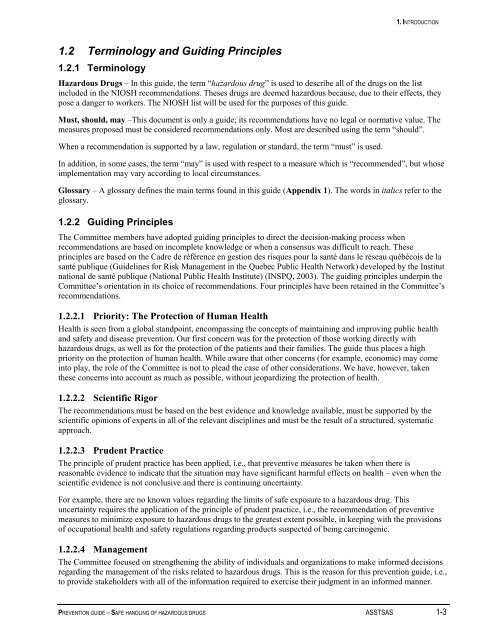Prevention Guide - Safe Handling of Hazardous Drugs - Irsst
Prevention Guide - Safe Handling of Hazardous Drugs - Irsst
Prevention Guide - Safe Handling of Hazardous Drugs - Irsst
Create successful ePaper yourself
Turn your PDF publications into a flip-book with our unique Google optimized e-Paper software.
1. INTRODUCTION<br />
1.2 Terminology and Guiding Principles<br />
1.2.1 Terminology<br />
<strong>Hazardous</strong> <strong>Drugs</strong> – In this guide, the term “hazardous drug” is used to describe all <strong>of</strong> the drugs on the list<br />
included in the NIOSH recommendations. Theses drugs are deemed hazardous because, due to their effects, they<br />
pose a danger to workers. The NIOSH list will be used for the purposes <strong>of</strong> this guide.<br />
Must, should, may –This document is only a guide; its recommendations have no legal or normative value. The<br />
measures proposed must be considered recommendations only. Most are described using the term “should”.<br />
When a recommendation is supported by a law, regulation or standard, the term “must” is used.<br />
In addition, in some cases, the term “may” is used with respect to a measure which is “recommended”, but whose<br />
implementation may vary according to local circumstances.<br />
Glossary – A glossary defines the main terms found in this guide (Appendix 1). The words in italics refer to the<br />
glossary.<br />
1.2.2 Guiding Principles<br />
The Committee members have adopted guiding principles to direct the decision-making process when<br />
recommendations are based on incomplete knowledge or when a consensus was difficult to reach. These<br />
principles are based on the Cadre de référence en gestion des risques pour la santé dans le réseau québécois de la<br />
santé publique (<strong>Guide</strong>lines for Risk Management in the Quebec Public Health Network) developed by the Institut<br />
national de santé publique (National Public Health Institute) (INSPQ, 2003). The guiding principles underpin the<br />
Committee’s orientation in its choice <strong>of</strong> recommendations. Four principles have been retained in the Committee’s<br />
recommendations.<br />
1.2.2.1 Priority: The Protection <strong>of</strong> Human Health<br />
Health is seen from a global standpoint, encompassing the concepts <strong>of</strong> maintaining and improving public health<br />
and safety and disease prevention. Our first concern was for the protection <strong>of</strong> those working directly with<br />
hazardous drugs, as well as for the protection <strong>of</strong> the patients and their families. The guide thus places a high<br />
priority on the protection <strong>of</strong> human health. While aware that other concerns (for example, economic) may come<br />
into play, the role <strong>of</strong> the Committee is not to plead the case <strong>of</strong> other considerations. We have, however, taken<br />
these concerns into account as much as possible, without jeopardizing the protection <strong>of</strong> health.<br />
1.2.2.2 Scientific Rigor<br />
The recommendations must be based on the best evidence and knowledge available, must be supported by the<br />
scientific opinions <strong>of</strong> experts in all <strong>of</strong> the relevant disciplines and must be the result <strong>of</strong> a structured, systematic<br />
approach.<br />
1.2.2.3 Prudent Practice<br />
The principle <strong>of</strong> prudent practice has been applied, i.e., that preventive measures be taken when there is<br />
reasonable evidence to indicate that the situation may have significant harmful effects on health – even when the<br />
scientific evidence is not conclusive and there is continuing uncertainty.<br />
For example, there are no known values regarding the limits <strong>of</strong> safe exposure to a hazardous drug. This<br />
uncertainty requires the application <strong>of</strong> the principle <strong>of</strong> prudent practice, i.e., the recommendation <strong>of</strong> preventive<br />
measures to minimize exposure to hazardous drugs to the greatest extent possible, in keeping with the provisions<br />
<strong>of</strong> occupational health and safety regulations regarding products suspected <strong>of</strong> being carcinogenic.<br />
1.2.2.4 Management<br />
The Committee focused on strengthening the ability <strong>of</strong> individuals and organizations to make informed decisions<br />
regarding the management <strong>of</strong> the risks related to hazardous drugs. This is the reason for this prevention guide, i.e.,<br />
to provide stakeholders with all <strong>of</strong> the information required to exercise their judgment in an informed manner.<br />
PREVENTION GUIDE – SAFE HANDLING OF HAZARDOUS DRUGS ASSTSAS 1-3

















